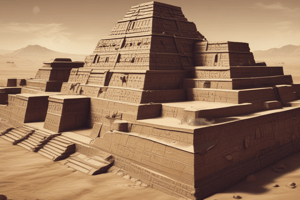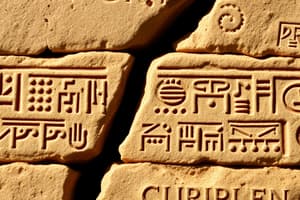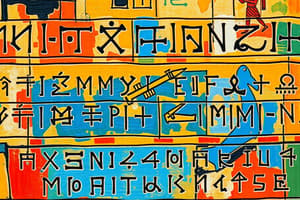Podcast
Questions and Answers
What geographical feature was crucial for the development of Egyptian Civilization?
What geographical feature was crucial for the development of Egyptian Civilization?
- The Nile River (correct)
- The Red Sea
- The Mediterranean Sea
- The Sahara Desert
Which of the following deities was considered the god of the dead in Ancient Egypt?
Which of the following deities was considered the god of the dead in Ancient Egypt?
- Anubis (correct)
- Horus
- Thoth
- Ra
What was the primary role of the pharaoh in Ancient Egyptian society?
What was the primary role of the pharaoh in Ancient Egyptian society?
- The intermediary between the gods and the people (correct)
- Military leader only
- Religious authority only
- Chief tax collector
Which goddess presided over the judgements of the deceased in Ancient Egypt?
Which goddess presided over the judgements of the deceased in Ancient Egypt?
Which title did the highest-ranking official in Ancient Egypt hold?
Which title did the highest-ranking official in Ancient Egypt hold?
What does the term 'Mesopotamia' mean?
What does the term 'Mesopotamia' mean?
Which geographic feature was essential for the agricultural development of ancient Mesopotamia?
Which geographic feature was essential for the agricultural development of ancient Mesopotamia?
Which god was associated with kingship and considered the highest deity in Mesopotamia?
Which god was associated with kingship and considered the highest deity in Mesopotamia?
Which of the following roles did Ishtar fulfill in Mesopotamian mythology?
Which of the following roles did Ishtar fulfill in Mesopotamian mythology?
What was a significant legacy left by the Mesopotamian civilization?
What was a significant legacy left by the Mesopotamian civilization?
Flashcards
Mesopotamia's location
Mesopotamia's location
Mesopotamia was located between the Tigris and Euphrates rivers, in a region called the Fertile Crescent.
Mesopotamia's religion
Mesopotamia's religion
Mesopotamian religion was polytheistic, meaning they believed in many gods, each associated with natural forces and city-states.
Anu
Anu
Anu was the chief Mesopotamian god of the sky and kingship.
Enlil
Enlil
Signup and view all the flashcards
Ziggurats
Ziggurats
Signup and view all the flashcards
Gift of the Nile
Gift of the Nile
Signup and view all the flashcards
Polytheism in Ancient Egypt
Polytheism in Ancient Egypt
Signup and view all the flashcards
Theocracy in Ancient Egypt
Theocracy in Ancient Egypt
Signup and view all the flashcards
Vizier
Vizier
Signup and view all the flashcards
Study Notes
Ancient Mesopotamia
- Mesopotamia was located between the Tigris and Euphrates rivers.
- Called the "Cradle of Civilization" due to significant contributions to early human history.
- Famous for ziggurats, advanced irrigation, cuneiform writing, and a complex social structure.
- Innovations in law, trade, and agriculture shaped future civilizations.
- Polytheistic religion with key gods representing natural forces and city-state importance.
- City-states ruled by kings believed to hold divine authority.
- Cuneiform, the first writing system, used wedge-shaped marks on clay tablets.
- Created the Epic of Gilgamesh, an early known work of literature.
Geography
- Fertile land between Tigris and Euphrates rivers, known as the Fertile Crescent, supported agriculture.
- Rich soil and water enabled the development of irrigation systems, cities, and a large population.
Religion
- Polytheistic belief system; gods represented natural forces and city-states.
- Key gods included Anu (sky god), Enlil (wind and agriculture), Ishtar (love, fertility, and war), Ea (water, wisdom, and creation), Shamash (sun and justice), and Marduk (Babylonian chief god).
Government
- Theocratic monarchy, with kings believed to have divine authority.
- Laws like the Code of Hammurabi guided justice.
- Scribes and priests played key administrative roles.
New Peoples from Asia Minor and Surrounding Areas
- Hittites: Skilled ironworkers, lived in modern-day Turkey from 1600-1178 BCE. Known for their legal codes, diplomacy, and polytheistic religion.
- Phoenicians: Seafaring traders from modern Lebanon (1500-300 BCE). Developed the Phoenician alphabet and skilled craftsmen.
- Lydians: Lived in Western Anatolia (modern Turkey, 1200-546 BCE). Developed the first coinage systems, revolutionizing trade.
- Hebrews: Ancient Semitic people who lived in Canaan (modern Israel/Palestine). Known for monotheism (belief in Yahweh) and key figures like Abraham, Moses, and King David.
Ancient Egypt
- Civilization thrived along the Nile River for over 2,500 years.
- Known for architecture, art, culture, a complex social system, hieroglyphic writing, and religious beliefs.
- The Nile River was essential to their civilization.
- Polytheistic belief system, with gods representing natural phenomena and aspects of life.
Government
- Theocracy, ruled by pharaohs considered divine intermediaries between gods and people.
- Bureaucracy supported the pharaoh, handling administration, tax, and military affairs.
- Vizier as chief advisor, overseeing administration.
- Hierarchical society with pharaoh at the top, followed by nobility, priests, scribes, and common people.
- Ma'at, representing truth, justice, and order, was central to Egyptian ideology. - Hieroglyphics (writing system) recorded events and religious beliefs.
Periods of Ancient Egypt
- Old Kingdom (2686-2181 BCE): Known as the "Age of Pyramids," featuring powerful pharaohs and renowned pyramid building.
- Middle Kingdom (2055-1786 BCE): After political turmoil, experienced a period of stability and trade.
- New Kingdom (1567-1085 BCE): Considered Egypt's most powerful period, characterized by extensive conquests and achievements in infrastructure and art.
Ancient Greece
- Mainland Greece was mountainous, impacting Greek life and civilization.
- Minoan Civilization (Bronze Age): Flourished on Crete, known for art, architecture, and maritime trade.
- Mycenaean Civilization: Developed on the Greek mainland, followed the Minoans; known for warrior elite, architecture ("Lion Gate"), and Linear B.
- Greek Dark Ages: Followed the collapse of the Mycenaeans, marked by loss of writing and decline.
- Classical Period: Greek democracy, drama, philosophy flourished (479 - 323 BCE).
- Polytheistic Religion: Gods associated with nature and aspects of human life.
- Key Gods: Zeus (king of the gods), Hera (queen), Poseidon (sea god), etc.
- Philosophy flourished with key figures like Socrates, Plato, and Aristotle.
Ancient Rome
- Located in Italy, a peninsula extending into the Mediterranean Sea.
- Early Rome was a monarchy, founded by Romulus and Remus.
- The Roman Republic (509 BCE - 27 BCE) was characterized by a system of checks and balances (Senate, Consuls, Popular Assemblies).
- The Roman Republic expanded through conquest, resulting in a vast empire.
- The Roman Empire (27 BCE - 476 CE) was a period of peace and prosperity, known as the Pax Romana.
- The Western Roman Empire fell in 476 CE due to numerous internal problems and barbarian invasions.
The Crusades
- Series of religious wars from the 11th to 13th centuries.
- Driven by religious fervor, political ambitions, and economic motives.
- Primarily focused on reclaiming Jerusalem and other holy sites.
- Led to significant economic and cultural exchanges, religious and political relationships between Europe and the Islamic world.
- Weakened the Byzantine Empire, especially the Fourth Crusade.
Studying That Suits You
Use AI to generate personalized quizzes and flashcards to suit your learning preferences.




